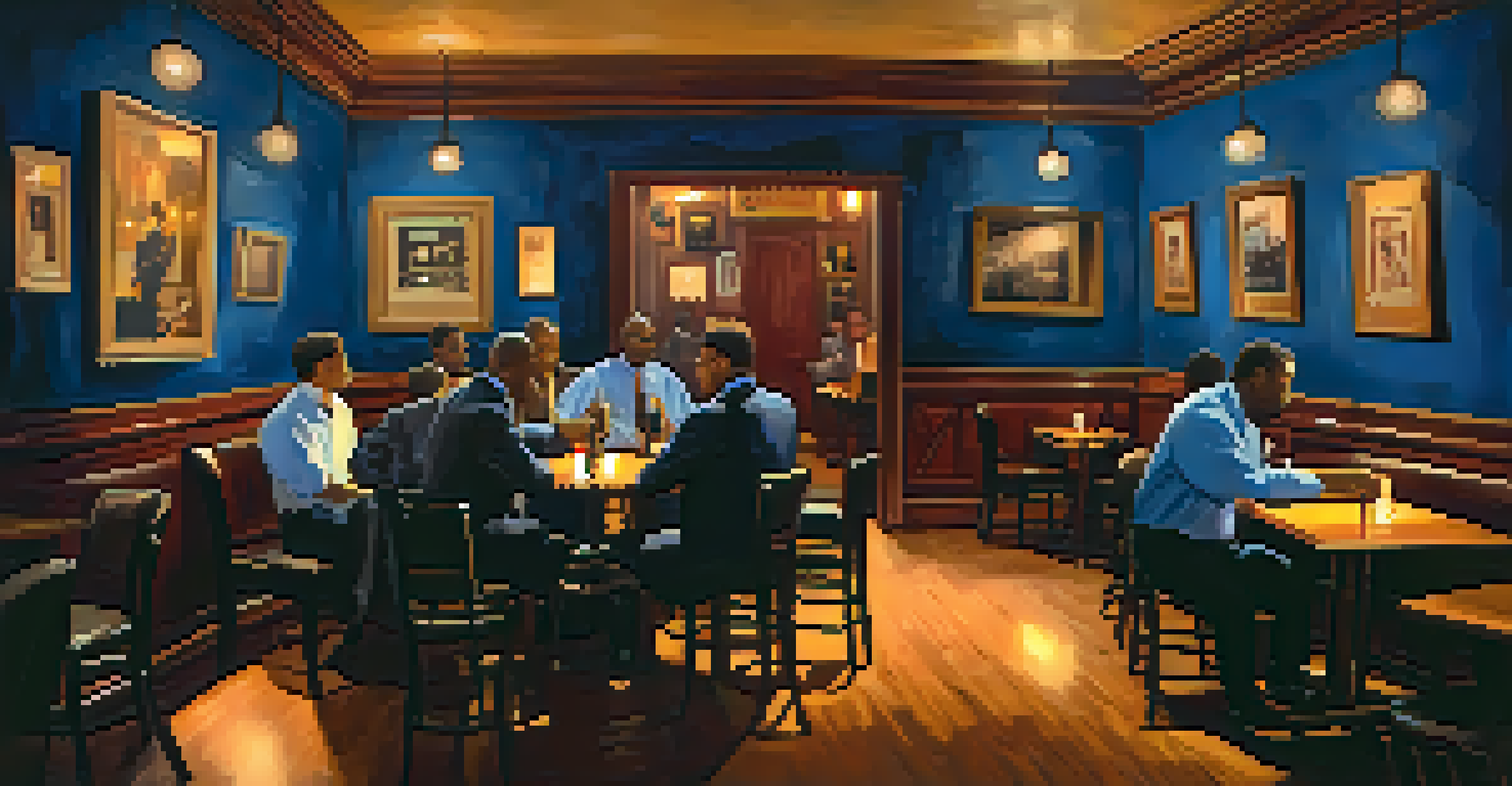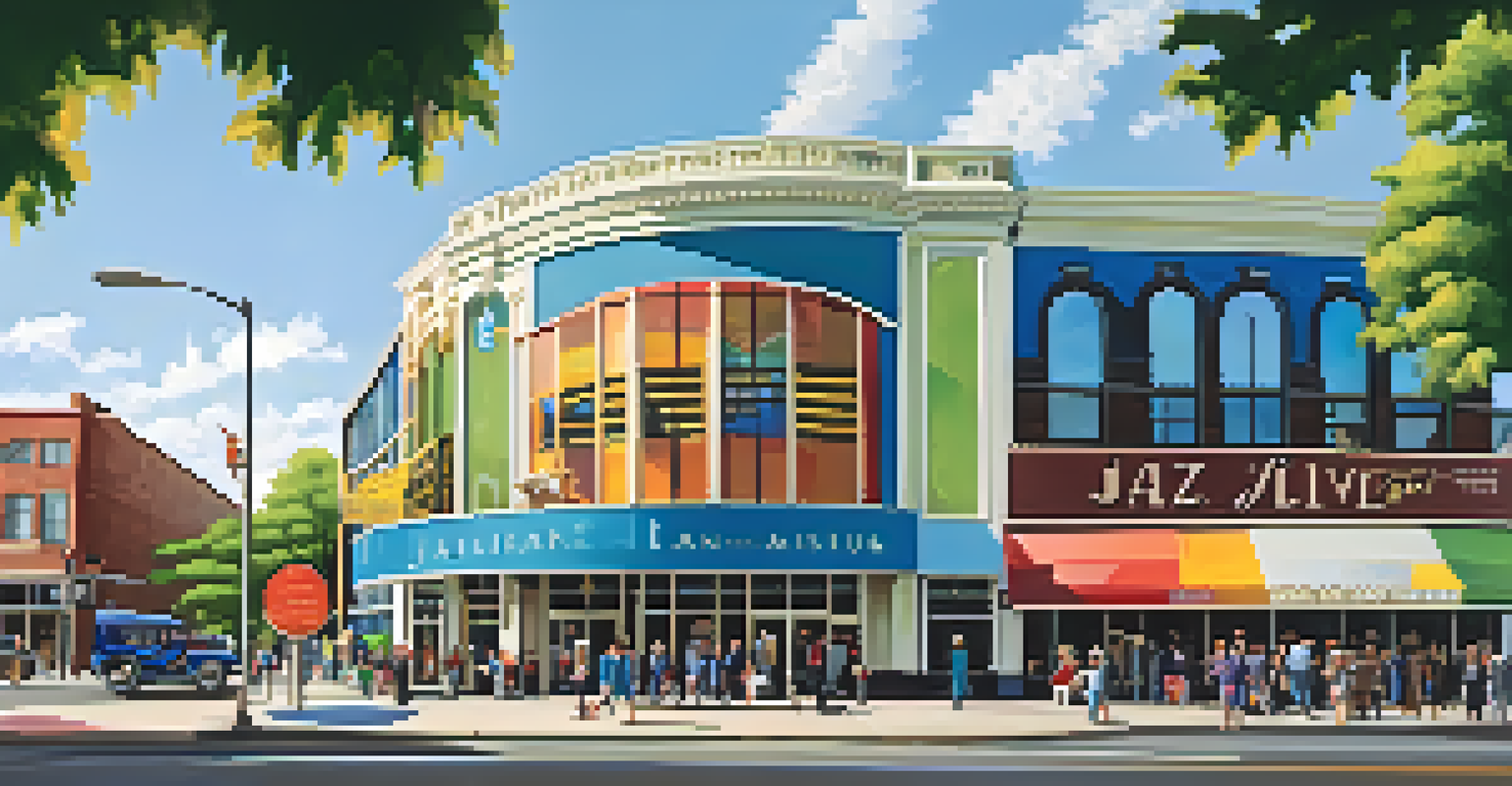A Journey Through the Historic 18th and Vine Jazz District

The Birth of the 18th and Vine Jazz District
The 18th and Vine Jazz District, located in Kansas City, Missouri, is a vibrant testament to the city’s rich musical history. Emerging in the early 20th century, it became a cultural epicenter for jazz, attracting legendary musicians like Count Basie and Charlie Parker. This area was not just about music; it served as a gathering place for the African American community during the segregation era, fostering creativity and resilience.
Jazz is the only music in which the same note can be played night after night but differently each time.
As you stroll through the district, you can almost hear the echoes of the past, with the sounds of jazz filling the air. The buildings, many of which are still standing, have stories to tell—stories of late-night jam sessions and the birth of new musical styles that would influence jazz around the world. It's a place where history and music intertwine, making it a vital part of America's cultural tapestry.
Today, the district is a blend of historic charm and modern-day attractions, making it a must-visit for music lovers and history buffs alike. Festivals and events often celebrate its legacy, ensuring that the spirit of jazz continues to thrive. The 18th and Vine Jazz District is not just a location; it's the heart and soul of Kansas City’s music scene.
Iconic Venues: Where Legends Performed
One cannot talk about the 18th and Vine Jazz District without mentioning its iconic venues, such as the Blue Room and the Mutual Musicians Foundation. The Blue Room, part of the historic Jazz District, has hosted countless performances that shaped the jazz genre. With its intimate setting, it provides a unique atmosphere where every note resonates with history.

The Mutual Musicians Foundation, on the other hand, is a cornerstone of jazz culture. Founded in 1917, it has served as a meeting place for musicians, giving rise to jam sessions that have created legendary collaborations. This venue showcases the importance of community in the jazz genre, where musicians come together to share their craft and inspire one another.
Jazz District's Historic Significance
The 18th and Vine Jazz District is a vibrant reflection of Kansas City’s rich musical heritage and cultural history.
Visiting these venues offers a glimpse into the past while highlighting their ongoing role in the music community. Whether you’re there for a live performance or simply to absorb the ambiance, these locations allow you to feel the pulse of jazz history. Each note played within these walls carries the legacy of those who came before, creating a rich tapestry of sound and spirit.
The Influence of Kansas City Jazz
Kansas City jazz is known for its unique style, characterized by its improvisational flair and swing. This genre emerged from the blending of blues, ragtime, and the jazz sounds of New Orleans, creating something distinctly its own. Musicians like Count Basie and Jay McShann were pivotal in developing this sound, bringing it to life in the clubs of 18th and Vine.
The great thing about jazz is that there’s no rules. You just do what you feel.
What sets Kansas City jazz apart is its emphasis on solo improvisation, allowing musicians to express themselves freely. This open approach to performance created a vibrant scene where artists could experiment and collaborate, leading to innovative techniques and compositions. It’s a style that prioritizes creativity, allowing each musician to shine in their own right.
As you delve into the history of 18th and Vine, you’ll discover how this unique sound influenced jazz across the nation and even internationally. The legacy of Kansas City jazz is a reminder of how local cultures can shape and redefine entire genres. Exploring this influence offers a deeper understanding of jazz as an art form, showcasing its evolution through the years.
The Role of the African American Community
The 18th and Vine Jazz District is intrinsically tied to the African American community's experience in Kansas City. During the Jim Crow era, the district served as a refuge for Black musicians and residents, providing a space for cultural expression amidst widespread discrimination. This community fostered a rich artistic environment where creativity could flourish, giving birth to many of the jazz legends we celebrate today.
The district’s significance goes beyond music; it represents resilience and unity in the face of adversity. The vibrant nightlife and cultural events that thrived here were essential for the community's social fabric, offering a sense of belonging and pride. This network of support helped nurture talent and foster a rich cultural exchange that continues to influence the arts today.
Influence of Iconic Venues
Venues like the Blue Room and Mutual Musicians Foundation played pivotal roles in shaping jazz culture and fostering collaboration among musicians.
Today, the legacy of the African American community in 18th and Vine is celebrated through various cultural events and educational programs. By honoring this history, we not only pay tribute to those who came before but also inspire future generations of artists and musicians. The district stands as a powerful reminder of the strength and creativity that can emerge from challenging circumstances.
Annual Events: Celebrating Jazz Heritage
Every year, the 18th and Vine Jazz District comes alive with festivals and events that celebrate its rich musical heritage. Events like the Kansas City Jazz & Heritage Festival attract jazz enthusiasts from all over, showcasing local talents and renowned artists alike. These gatherings provide a platform for musicians to connect with audiences, ensuring the spirit of jazz remains vibrant.
During these festivals, attendees can enjoy live performances, food vendors, and art displays, creating a festive atmosphere that honors the district’s cultural roots. Workshops and panel discussions often accompany these events, offering insights into the history and evolution of jazz. It's a wonderful opportunity for both seasoned fans and newcomers to immerse themselves in the world of jazz.
These annual celebrations are more than just entertainment; they are a tribute to the legacy of 18th and Vine. They remind us of the importance of community in preserving cultural heritage and fostering new talent. Each year, as the sounds of jazz fill the air, the district reaffirms its status as a cornerstone of musical history.
Preservation Efforts: Keeping the Legacy Alive
Preserving the rich history of the 18th and Vine Jazz District is essential for future generations. Local organizations and historical societies work tirelessly to maintain the integrity of the area, ensuring that its stories and contributions to music are not forgotten. This involves everything from restoring historic buildings to promoting educational programs about the district’s significance.
Efforts to preserve this cultural heritage also include creating awareness through art and media. Documentaries, books, and exhibitions showcase the stories of the musicians and the impact of the jazz scene in Kansas City. By sharing these narratives, they help foster a deeper appreciation for the district’s history and its ongoing influence on music today.
Community's Role in Jazz Legacy
The African American community's resilience and creativity in the 18th and Vine area significantly contributed to the development and preservation of jazz music.
Through these preservation efforts, the spirit of 18th and Vine continues to thrive. It’s a commitment to honoring the past while inspiring future musicians and artists. The legacy of jazz is not just about the music; it’s about the community, creativity, and culture that shaped it, making preservation efforts vital for keeping that legacy alive.
Visiting the 18th and Vine Jazz District Today
Visiting the 18th and Vine Jazz District today offers an immersive experience into the heart of jazz culture. As you explore, you’ll find museums, galleries, and live music venues that capture the essence of this historic area. The American Jazz Museum is a highlight, showcasing exhibits dedicated to the legends of jazz and the evolution of the genre.
While wandering through the district, take a moment to appreciate the vibrant street art and murals that pay homage to jazz greats. These artistic expressions serve as a visual representation of the district’s rich history and its ongoing relevance in the music world. Each piece tells a story, inviting you to delve deeper into the cultural significance of the area.

Whether you’re a local or a visitor, spending time in the 18th and Vine Jazz District is a journey through time. It’s an opportunity to connect with the music and the stories that shaped a genre while celebrating the resilience and creativity of the community. As you soak in the atmosphere, you’ll leave with a greater understanding and appreciation for the legacy of jazz.